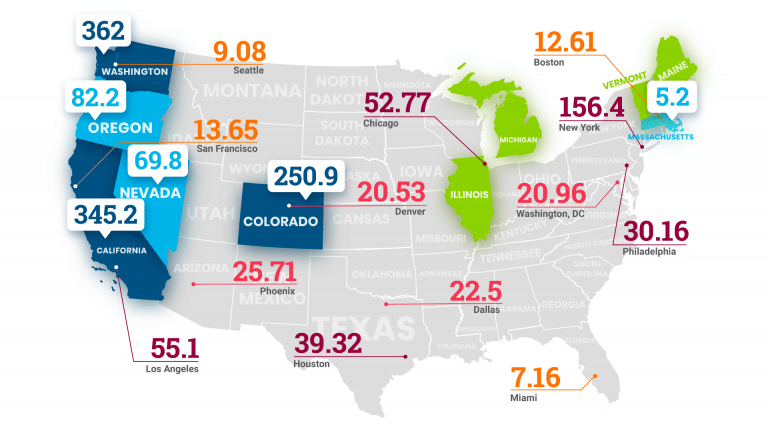37 Curious Disability Statistics That Concern All of Us

Having a disability doesn’t mean having only health issues. The problem is more complex than that since it affects how society perceives them. Disability statistics show that people with disabilities battle not only their bodies and minds, but they need to overcome social and environmental difficulties as well.
The term disability covers various types of impairments, different limitations and restrictions in participating in different activities. We’re going to cover a great deal of them via our facts and stats, and even include some coronavirus statistics too that concern disability.
First, let’s take a look at the most intriguing stats and facts:
Top 10 Facts & Disability Statistics for 2022
- 61 million adult Americans have some form of disability.
- 1 million workers with disabilities have lost their job since the beginning of the pandemic.
- There are about 7.1 million disabled students in the US.
- 1% of the global population is intellectually disabled.
- 3,000–5,000 children are born with Down Syndrome every year.
- 15% of people worldwide have some form of disability.
- 2.8 million people around the world have multiple sclerosis.
- 49.1 million people in the world are blind.
- In Massachusetts, 98.3% of people with disabilities have health insurance.
- Social security beneficiaries were expected to see an increase in monthly checks of 1.3% in 2021.
To find out more about people with special needs, what the most common disabilities are, and how medical marijuana and disability are connected, keep reading.
Disability Statistics in America
How many people in the US live with a disability?
1. 61 million adult Americans have some form of disability.
(CDC)
26% of adult Americans have a form of disability. That’s 1 in 4 Americans that are facing daily challenges.
The highest percentage of the disabled comes from the South. As for most common disabilities, 13.7% of disabled Americans are challenged in terms of mobility, followed by cognition disability (10.8%). Independent living is a challenging goal to reach for 6.8% of the disabled.
2. 19.3% of Americans with a disability are employed, according to the most recent disability employment statistics report.
(BLS)
In other words, 22.5% of men and 16.5% of women with a disability had a job. When it comes to age, the highest percent of workers, or 43.5%, made 25 to 34 years old, followed by 40.2% of people between 20 and 24, and 38.5% of people 35 to 44 years old.
The lowest percent of workers, 7.6%, was comprised of over-65-year-olds.
3. Disability statistics annual report 2019 presented results that the unemployment rate is 7.3% for women and 7.4% for men.
(BLS)
Based on the most recent data, the unemployment rates are highest among 16–19-year-olds (21.7%) and lowest among 65+ years old (4.3%). Furthermore, 11.8% of the unemployed individuals with a disability were Black and African Americans, Hispanic or Latino (8.6%), Asian (6.7%), and white (6.6%).
4. About 1 million workers with disabilities have lost their job since March 2020, disability and coronavirus stats show.
(SHRM)
The studies suggest that 1 in 5 workers with disabilities have stopped working since March 2020. In contrast, the general average is 1 in 7 for healthy workers. As workers with disabilities were more likely to be hired last, the politics of firing the last employed was partially responsible.
5. 33% of US students struggle with a specific learning disability.
(NCES)
19% have speech or language impairment, whereas 11% are diagnosed with autism.
While 7% of students have developmental delay, 6% are intellectually disabled. Only 1% of students suffer from hearing impairment and orthopedic impairment.
6. Disability statistics from 2020 show that only 20% of children in special education received the entitled support during the pandemic.
(NY Times)
Due to the coronavirus crisis, many schools were forced to close their doors and switch to online education. On that matter, according to one survey, 40% of children with disabilities didn’t receive the support they were entitled to. Moreover, only a third of children were engaged in little to no remote learning.
Intellectual Disability Statistics
Intellectual disability, or cognitive disability, occurs when a person has intellectual, practical, and social functioning problems. How many people are intellectually disabled?
7. Over 7 million people in the US endure some form of intellectual disability.
(ProPublica) (MedicalNewsToday)
If a persona has an intellectual disability, their cognitive skills and functioning are limited. This is the most common developmental disability. The prevalence of intellectual disability data shows it can occur at any time from birth until the age of 18 or even before birth.
While the exact cause is still a mystery, it can be a result of injuries, diseases, or specific brain conditions.
8. 1% of the global population is intellectually disabled.
(MedicalNewsToday)
Having an IQ below 70–75 is one of the three criteria for having an intellectual disability. The other two criteria include the manifestation of the disability before the age of 18 and limitations in skills that are needed to live and work.
9. Intellectual disability prevalence figures reveal a great majority of intellectually disabled people have a mild disability — 85%.
(Exploring Your Mind)
The figures show 10% of the disabled have a moderate disability; up to 4% suffer from severe disability, and up to 2% of disabled people have a profound disability. Their IQs are usually around 20–25, and they completely depend on other people.
People with a mild disability aren’t easily diagnosed when they are children. Their short-term memory and abstract thinking are affected, but it seems that they’re not different from healthy children, that is, until they grow up.
10. 3,000–5,000 children worldwide are born with Down Syndrome every year, intellectual disability facts report.
(CDC) (UN)
This is one of the most common intellectual disabilities, with a prevalence of 1 in 1,000 to 1 in 1,100 births worldwide. Scientists have found that one extra chromosome causes this problem, but no one is sure why this happens.
People with this syndrome have mild to moderate disabilities, and speaking clearly is often challenging for them.
11. The number of American children with at least one learning disability exceeds 4 million.
(Healthy Place)
Disability abuse statistics report that children with learning disabilities have 31% more chances to be bullied than children without such challenges.
The same research has found that approximately 45% of parents of the children admitted that their child had been bullied.
12. People with developmental disorders have substantially higher COVID-19 mortality rates.
(FAIR Health)
Based on a New York State study, the coronavirus mortality rate among people with developmental disorders and intellectual disabilities was 1,175 per 100,000 people, compared to the New York State overall Covid death rate (151 per 100,000).
Additionally, various studies insinuate that coronavirus patients with developmental disorders had the highest probability of dying from the new virus.
Disability Statistics Worldwide for 2022
How many people in the world have a disability?
13. Approximately 15% of people worldwide have some form of disability.
(WHO)
The prevalence of worldwide disability is higher than ever, with over 1 billion people struggling with some form of disability. On top of that, 3.8% of people over 15 years old experience serious difficulties in everyday life. That’s 190 million experiencing daily issues.
The high rise in this number is partially caused by the increase of chronic diseases and the aging population.
14. Judging by rheumatoid arthritis disability statistics, RA affects approximately 1.3 million people in the US, and 1% of the global population.
(MedlinePlus)
According to the report, women are 2–3 times more likely to suffer from this disability. Rheumatoid arthritis is detrimental not only for the joints, but it can affect the whole body. In some cases, it can also attack organs like lungs, blood vessels and eyes. In order to eliminate or diminish painful sensations, some patients use CBD oil for arthritis.
15. 2.8 million people around the world have multiple sclerosis.
(Sage Journals) (Healthline)
As multiple sclerosis disability statistics reveal, 35.9 in 100,000 people suffer from it. The two most common symptoms of this disease include weakness in the legs and fatigue.
Other symptoms can include tremors, concentration and memory problems, speech disorders, and acute or chronic pain.
16. A person with multiple sclerosis spends up to $62,000 per year on medical treatment.
(Restoration Spinal Care)
This is an immensely expensive illness to treat, and the cost depends on how much the disease has progressed.
17. Worldwide blind disability facts are very grim — 49.1 million people in the world are blind.
(IOVS)
Judging by the, 221.4 million people had moderate vision impairment, followed by 33.6 million that reported having severe vision impairment in 2020.
18. In seven years there were 252,599 filed complaints about disability-related discrimination in the workplace, out of which only 21% received some relief.
(The Washington Post)
The statistics tell us that the most frequent discrimination types, besides medical and disability discrimination, include retaliation, age, sex, and racial discrimination.
Social Security Disability Statistics
What do you need to know about the social security benefits?
19. Social security beneficiaries were expected to see an increase in monthly checks of 1.3% in 2021.
(CNBC)
This increase refers to all US citizens who receive social security and SSI benefits. This means that disabled workers would receive an average monthly benefit of $1,277.
20. The SSA may require a Continuing Disability Review every 6 months to 7 years.
(Allsup)
Continuing disability review statistics say it depends on how likely the person is to recover. If someone is expected to recover from an injury or illness, they’ll be reviewed 6 to 18 months after the benefits program starts.
People likely to recover will probably be reviewed after 3 years. However, if the improvement isn’t expected, it will take the Social Security Administration 5 to 7 years to review their case.
21. The 2020 disability statistics annual report shows 46% of people with disabilities have private health insurance.
(Disability Compendium)
Based on the most recent report, 89.6% of people with disabilities have health insurance, compared to 86.9% of people with no disabilities.
However, when it comes to private health insurance, the numbers tell us a different story. Only 46% of people with disabilities have private health insurance, compared to 75.8% of people with no disabilities.
22. In Massachusetts, 98.3% of people with disabilities have health insurance.
(Zeus)
Social security disability statistics by state reveal that Massachusetts is the best state for people with disabilities, followed by Vermont with 97.7% of people with health insurance, and Maryland with 96%.
22. Approximately 69.1 million people received SSA benefits in 2019.
(SSA.gov)
88% of people (61 million) obtained only OASDI benefits, in addition to 8% of people (5.4 million) who received only SSI benefits. What’s more, disability insurance statistics report that only 4% of people (2.7 million) used the benefits from both OASDI and SSI.
23. 43% of beneficiaries are older than 65.
(SSA.gov)
While almost half of the OASDI beneficiaries are between 65 and 74, 24% are 75–84 years old, and 9% are older than 85. 12% of the beneficiaries are people between 18 and 61, while 4% of beneficiaries are children under 18.
24. 64% of people who apply for benefits get rejected at the beginning of the application process.
(Social Security Resource Center)
More than 85% of applicants are rejected when they file for reconsideration, according to disability appeals council statistics.
When someone applies for this program, the SSA requires medical records from the applicant’s doctor, as well as information about their condition from their doctor and themselves. This is a long, tiring process, so many people get discouraged from even applying for the program.
25. Kansas has the highest SSDI approval rate of 69.7%.
(Finder)
Besides Kansas, New Hampshire is the second state with high rates of SSDI approval—66.1%, followed by Wyoming (60.3%), Alaska (59.9%), and Nebraska (57.4%). The data is from the year 2020, but more recent reports are yet to be made.
26. U.S. disability statistics from 2020 reveal only 33.4% of people received approval for social security disability in Oklahoma.
(Finder)
Oklahoma is the state with the lowest SSDI approval rates. Next was Arizona, with an SSDI approval rate of 37.1%, followed by Mississippi (38.5%), Texas (39.0%), and Florida (39.1%).
11 Medical Marijuana and Disability Statistics
How can medical marijuana help people with disabilities?
27. Zygel has promising results for patients with Fragile X syndrome.
(Zynerba Pharmaceuticals) (National Fragile X Foundation)
Scientists are optimistic that CBD in the form of Zygel could help children with Fragile X syndrome. Cannabidiol is supposed to energize the brains of these children and calm their anxiety.
Zygel is a permeation-enhanced CBD transdermal gel and the next logical step is waiting for the FDA approval. The medicine is still in its experimental phase but the hopes are high for those with full methylation of the FMR1 gene.
28. Disability statistics report that 80% of children with autistic spectrum disorder showed improvement after using CBD oil.
(Leafy) (Science Direct)
Researchers treated children who suffered from autism with CBD oil for seven months, after which 80% of the parents reported improvement in problematic behaviors. Additionally, more than 60% of the parents noted overall improvements in their children, and 40% reported lower levels of anxiety.
29. One of the most important disability facts today: Epidiolex is the only FDA-approved cannabis oil for epilepsy.
(Medical News Today)
Epidiolex is prescribed for treating Dravet syndrome and Lennox–Gastaut syndrome, two very rare types of epilepsy.
It’s an expensive medication, but some of the CBD companies that give discounts for disability include Lazarus Naturals, Bluebird Nauticals, and RopaNa.
30. Cannabis controls the progression of muscular dystrophy.
(MMTC)
Muscular dystrophy causes muscle cramps, chronic pain, and spasms, which can be relieved with the help of medicinal marijuana. Some of the latest disability statistics for America show that cannabis reduces the severity and lengths of these symptoms.
31. 56% of Americans with multiple sclerosis used CBD to help them sleep.
(Sage Journals)
Based on one study’s results, for 1,027 American patients with multiple sclerosis, CBD was primarily used for sleeping problems and pain relief. In fact, 78% of patients believe it offered more than one sleep benefit, while 82% believe that CBD helped them fall asleep.
32. Disability statistics about cerebral palsy confirm medicinal marijuana relieves the symptoms.
(Cerebral Palsy News Today)
Cerebral palsy affects muscle tone, posture, and movement, causing involuntary movements, uncommon reflexes, and limb floppiness. One study has discovered that out of all traditional medications and pain relief drugs, medicinal cannabis has the best effect in treating pain caused by cerebral palsy.
33. On average, insulin levels in cannabis users are lower by 16%.
(MedicalNewsToday)
Some of the physical disability statistics report that the antioxidant features in cannabis also lower the arterial inflammation, and keep the blood vessels open, which furthermore lowers the blood pressure and recovers circulation.
Medical marijuana also alleviates different pains caused by diabetes complications, and it can even help with weight loss, and decrease the risk of obesity.
34. CBD oil can decrease the number of spastic quadriplegia seizures from 50 a day to 2–3.
(Cerebral Palsy Guidance)
Disability facts describe spastic quadriplegia is the most serious form of cerebral palsy, and it affects the whole body. There are few reliable studies, though CNN’s documentary about Charlotte’s Web reached a wide audience. Charlotte, who was dealing with continual seizures as a child, had them reduced by using CBD oil.
35. Medical marijuana and CBD oil can calm the joint inflammation caused by RA, which should improve rheumatoid arthritis disability statistics.
(WebMD)
Since marijuana can help alleviate long-term pain, rheumatoid arthritis patients can use it to restrain the morning pain, as studies have discovered. CBD oil and marijuana can also help them achieve better sleep quality.
36. Alzheimer’s disease patients have clumps of protein built up in their brains, which can be removed with cannabis.
(Alzheimer’s Society)
Studies performed on lab mice have shown that patients with Alzheimer’s could improve their learning skills and decrease the number of protein clumps in the brain. The treatment included THC. Cannabis could also help with the behavioral symptoms of dementia.
37. Disability statistics report that 8% of US adults use CBD to manage their mental health conditions like ADHD and PTSD.
(Statista) (Verywell Mind)
While most people used CBD for pain relief and sleep problems, one 2020 study implies that a higher dosage of medical cannabis can be linked to the reduced use of ADHD medications. Although CBD has demonstrated outstanding mental health treatment potential so far, scientists still need to conduct further research to connect the endocannabinoid system with ADHD.
The Bottom Line
We hope that these disability statistics have answered your CBD and disability questions, and have lessened your worries. No matter if you or someone you care about suffer from an intellectual or physical disability, life can be made easier.
What is more, the aim of these statistics is to show the disability prevalence and (unfortunately) how common it is. Having accepted the above facts, perhaps the society could take it in its stride to make some improvements regarding the public attitude, laws and rules, as well as health services. Taking advantage of legalizing marijuana is definitely recommendable.
FAQs
What percentage of the population has a disability?
15% of the global population or 1 billion people worldwide are disabled. Nearly 190 million people older than 15 need healthcare services due to their inability to function normally.
That said, the rate of disability is higher in developing countries, and people there will more frequently have problems with employment, education, health outcomes, and high poverty rates.
How many Americans have a disability?
26% of the American population suffers from some form of disability. Looking at the US population by age group, it can be concluded that people older than 65 are the biggest disabled group. In fact, the stats show us that 2 in 5 adults over 65 have a disability.
In addition to that, about 7.1 million students (3–21 years old) have some form of a disability, from specific learning disabilities (33%), language impairment 19%, autism spectrum disorder (11%) to developmental delay (7%), intellectual disability (6%), and hearing impairment (1%).
What percentage of Australia has a disability?
18% of the people in Australia are disabled. Otherwise stated, 4.4 million people live with some form of a disability, of which 1.4 million (5.7% of the population) suffer from severe or profound disability (meaning they need daily help).
When it comes to age, the prevalence is highest among people over 65 (50%) and lowest among children aged 0–14 (7.6%).
What percentage of the UK has a disability?
About 20% of UK adults suffer from some form of disability. The most common impairment type among working-age adults is mobility impairment (40%), followed by mental health (39%), stamina (32%), and dexterity (24%).
On a related note, only 19% of the working-age adults (16–64 years old) with disabilities reported having a job in 2020.
Does disability health insurance cover medical weed?
Medicare can sometimes cover medical cannabis, as the disability insurance facts report, so you should make inquiries. Although medicinal cannabis is very efficient in treating various types of disabilities, it’s still not approved by the FDA as a safe alternative to traditional medications (unless we’re talking Epidiolex, Nabilone, and Dronabinol).
Can your disability be denied for testing positive for THC?
This largely depends on whether cannabis use is legal in the state, how smoking marijuana affects the progress of your disability, and whether cannabis relieves your psychiatric problems for which you receive the benefits or worsens them (the latter is usually regarded as likely).
If it’s not legal in the state, the approval chances are minimal.
What is the Number 1 disability in the world?
Blindness and visual impairment are the number one disability in the world. Namely, 1.3 billion people suffer from one or the other, which makes for 17% of the global population.
Similarly, disability statistics indicate dyslexia is the most common learning disability. As a matter of fact, 5% to 20% of the world population suffers from it. People with dyslexia have problems with reading, identifying speech sounds, and connecting letters with words.





